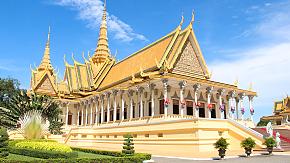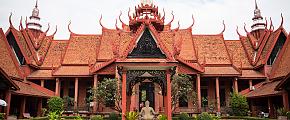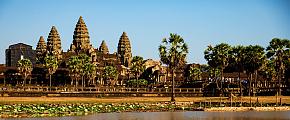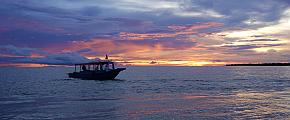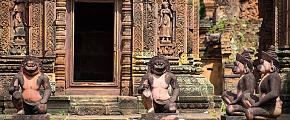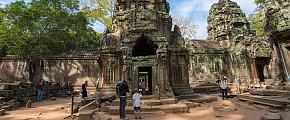Travel Guide of Angkor Ruins
Angkor ruins, located in Siem Riep, north of Cambodia, were built in 968 during the reign of King Jayavarman V. Angkor was the seat of the capital of Cambodia between the 9th and 15th centuries. More than 600 ruins have remained in Angkor, along with a vast expanse of virgin forest. Angkor's ruins include Angkor Thom, Angkor Wat, and other temples. Angkor ruins were listed as World Cultural Heritage by UNESCO in 1992 and are hailed as one of the Eight Wonders of the World. Today we'll offer you detailed information about the Angkor ruins.
The Best Attractions to Visit
Angkor Wat
Angkor Wat is considered the treasure of Cambodia. Here still stand a great number of ancient temples built by Khmer King Suryavarman II in the first half of the 12th century. The original name of Angkor Wat is Vrah Vishnulok, which means a Hindu temple dedicated to the god Vishnu. Until Angkor Wat was first founded in 1586, the grand temple, abandoned for over 100 years, had been tucked among primitive forests. In 1861, a French biologist called Henry Mouhot discovered the magnificent ruins by chance and wrote a book about his experience. Since then, Angkor Wat has become more and more famous around the world. At the heart of Angkor Wat, surrounded by a moat and lush trees, are five pyramid towers. The stairs to the top of the tower are quite steep. On a large scale, the grand complex was made entirely of sandstone. It is amazing that there is no mortar or other adhesive between the stones. Wall reliefs can be seen everywhere in Angkor Wat. The higher the reliefs are, the higher the status characters on them enjoy. Each type of relief resembles a painting. The galleries of Angkor Wat are also fascinating. They are decorated with exquisite sculpted reliefs about the story of the Hindu god and the personal history of the builder of the temple.
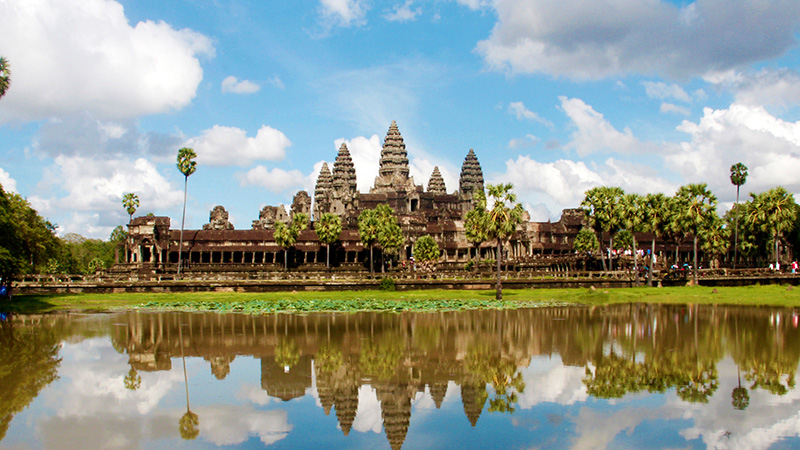 Angkor Wat
Angkor Wat
Bakheng Hill
Bakheng is a small hill at a height of 67 meters. It is 1500 meters northwest of Angkor Wat. At the top of the hill stands an old temple, Phnom Bakheng, built by Yasovarman I. Phnom Bakheng was the first state temple dedicated to the Hindu god Shiva in the Angkor Dynasty. The temple has 108 towers arranged symmetrically in a strict way. Although Bakheng Hill does not have the most breathtaking scenery of the Angkor ruins, it is the only place where tourists can see the entire Angkor Wat complex. The temple left to decay gives people a different sense of its former splendor.
Phimeanakas
In the northeast of Baphuon, Phimeanakas was built during the time of King Rjendravarman II. It is also a temple dedicated to Shiva. Phimeanakas means "palace in the air", but the real palace built of wood had, in fact, ceased to exist. The building was once extremely magnificent. You can enjoy the decorations of lions and elephants at the four corners of Phimeanakas. In addition, there remains a big men's bath called Srah Pros. It is decorated with vivid sculptures, like Garuda, a giant bird in ancient Indian mythology, fish, and many kinds of aquatic animals.
Bayon Temple
As a rare Buddhist temple, Bayon Temple is at the heart of Angkor Thom. It was built in the time of King Jayavarman VII. There are a total of 49 pagodas in the temple. The central pagoda is surrounded by another 48. At first sight, the 216 stone statues are shockingly mesmerizing with their gargantuan smiling faces. Among the temples of Angkor Ruins, it is the Khmer Smile that makes Bayon famous around the world. Furthermore, Bayon's walls are decorated with elaborately sculpted reliefs and mural paintings with a strong story. The subjects of the engraving art in Bayon are very diverse. You can turn to the tour guide for the connotation of the sculptures.
 Bayon Temple
Bayon Temple
Baphuon Temple
Baphuon Temple is just a few hundred meters northwest of Bayon Temple. It was a state temple built to be dedicated to Shiva in 1060, during the reign of Udayadityavarman II. Baphuon, in the shape of a pyramid, is a world-first temple built totally of sandstone. It is considered to be Mount Meru floating on the water. The temple has a base in the shape of a lotus flower and a tower covered with copper that is 50 meters high, higher than the gold one at the heart of Bayon. Baphuon is also known for its delicately sculpted reliefs depicting religious stories and daily life in Khmer.
Ta Prohm Temple
Ta Prohm, located east of Angkor Wat, is the 12th-century temple built by King Jayavarman VII in memory of his mother. The temple was constructed with stone. It boasts 260 sculptures of gods and a vast collection of diamonds, pearls, and gems. What distinguishes Ta Prohm from other temples is its magnificent combination of old buildings and huge trees. Due to the rainy and sunny climate, the kapok trees here grow well, with incredibly thick branches and huge roots. A spectacular view of intertwined giant roots grasping the walls and roofs can be seen. It seems like the whole temple is pressed against the giant trees. Besides, there is much to enjoy about the exquisitely sculpted reliefs in the temple. It was once used as a location for the movie Lara Croft: Tomb Raider.
Banteay Srei
Banteay Srei, located in Siem Reap, 25 kilometers away from Angkor city, was first built in 967 during the time of King Rajendravarman, and it took 35 years to finish during the reign of King Jayavarman V. It is acclaimed as the "brilliant pearl" of Angkor's ruins. Banteay Srei was constructed to honor the Hindu god Shiva. It is covered with sculpted reliefs, which are extremely vivid and exquisite. Banteay Srei includes three yards, all of which are decorated with gorgeous sculptures depicting stories of the Hindu god from ancient religious literature. The sculpted reliefs in the temple feature a variety of shapes, like Hindu gods, monsters, and guards.
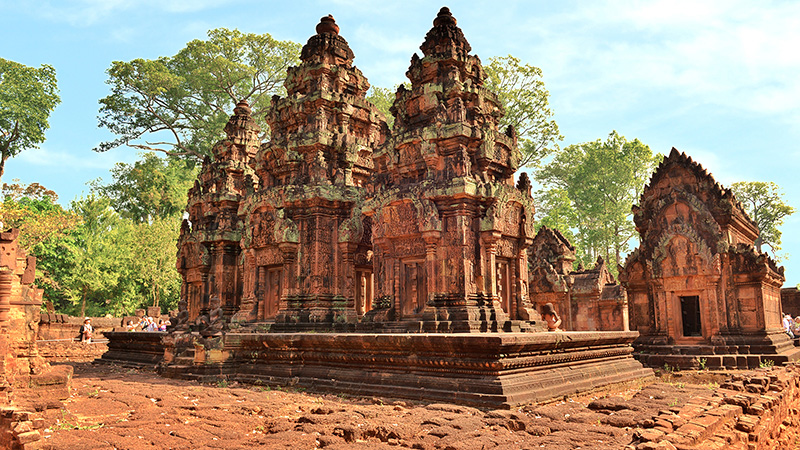 Banteay Srei
Banteay Srei
Pre Rup
On a large scale, Pre Rup is a pyramid of a state temple constructed with red bricks and was built once for royal cremation in the 10th century during the reign of King Rajendravarman. Pre-pup means "transform the body." The sun warms the old red brick building to a radiant glow. The temple has a broad view for tourists to admire the beautiful sunset. On the top floor of Pre Rup, a grand view of vast virgin forests will be attractive to visitors.
Best Places to Admire Sunrise and Sunset
Angkor Wat
Angkor Wat faces west. The best attraction to see the sunrise. You can stand on the bank of Lotus Pond early and will see the sun slowly rising behind Angkor Wat. In rainy seasons, Angkor Wat often rains in the afternoon. The rains refresh the air and fill the dry pond and moat. You will take a wonderful picture of a perfect combination of Angkor Wat, sun, and ponds. In dry seasons when the clouds are high and thin, you are more likely to see the brighter and more clearly visible sunrise. The best time to see the sunrise is about 5:00 a.m.
Bakheng Hill
1500 meters northwest of Angkor Wat. The highest place around the Angkor Wat. You can see the entire Angkor Wat complex at its top. It's the best place to admire the sunset. You may see a layered image including dark clouds, a clear sky, and the horizon, then watch the setting sun falling into Tonlé Sap Lake. When the sun goes down and shines over Bakheng and the old ruins, you will be reminded of the past splendor of Angkor. Up the hill before 5:00 p.m. No admission to Bakheng after 5:30.
The Best Time to Visit
The climate in Siem Reap is tropical monsoon. It has a dry season and a rainy season in a year. The small city is warm all year. The best time to visit Angkor Ruins is between December and next March, during the dry season when the attractions have clear and cool weather during the morning and evening.
If you want an immersive experience of Cambodia's festival culture, April is an ideal time to visit, as Khmer New Year is celebrated at that time. You may partake in many traditional events and games in addition to visiting Angkor Wat.
During the rainy season from June to October, it is usually sunny in the morning and rainy at noon and in the afternoon. It is the off-season for tourism when few tourists visit, and accommodation and transport costs are inexpensive. August is recommended if you're a photography fan and intend to avoid crowds. The temples in the rain will show you a distinctive picture.
How to Get There
Most of the temples of Angkor Ruins are in Siem Reap, so Siem Reap serves as the gateway to Angkor Ruins. The small city has an international airport 5 kilometers away from Angkor Wat. There are no non-stop flights from America, Europe, Australia, or Canada to Siem Reap, so you need to get a connecting flight.
From America: About 30 hours; the quickest is about 22 hours, with two stops.
From Europe: About 20 hours; the quickest is about 14 hours with two stops.
From Australia: About 24 hours; the quickest is about 12 hours with 1 or 2 stops.
From Canada: About 35 hours; the quickest is about 23.5 hours with 2 or 3 stops.
If you travel independently, you may take a tuk-tuk, a taxi, or even rent a car or a bicycle to explore the Angkor Ruins in Siem Reap. But, if you travel with Odynovo, you don't need to worry about this as we will arrange a private car/minibus for transfer throughout the journey.
Things to Bring
Sunscreen or sunbonnet: The sunshine in Angkor ruins is terribly hot during the dry season.
Insect repellent: The weather in Angkor ruins is wet and hot, and plants there flourish. In this climate, malarial insects, especially mosquitoes, can be seen everywhere.
Anti-dust mask: It will be dusty during your drive by tuk-tuk down the red earth road.
Feel-good shoes: You'll be doing a lot of walking and stair climbing, so wear comfortable shoes.
Mobile charger: 220V with a double plug because a three-pin plug is not available in Cambodia.
Flashlight: It is a useful aid for watching sunrise and sunset.
Camera: The magnificence of Angkor ruins will absolutely feed your camera.
Notes
Dress: On the one hand, it is extremely hot, and there are also a lot of mosquitoes and bugs in the tourist zone. Wearing pants and a long-sleeved shirt is a good way to protect yourself from the sun and insects. On the other hand, the Angkor Complex is a religious site. Locals have a taboo against exposed shoulders and knees.
Gesture: Don't eat food or take things with your left hand. The head is much more sacred to the Cambodians, so it's not advisable to touch local heads, including children's.
Currency: USD is available in Cambodia. USD can be used to purchase goods. It is better for you to take some small changes, like 1 dollar, 5 dollars, or 10 dollars.
Angkor ruins buildings: All Angkor ruins buildings are inaccessible. Leaning on temple structures is also prohibited.
Monks: You should show respect for monks as the locals do. Before shooting their pictures, you should have their approval.
The Angkor ruins are an important part of Cambodia that cannot be overlooked. With their exquisite craftsmanship and massive grandeur, the temples and carvings will undoubtedly leave a lasting impression on you. If you're excited about it, contact us. We will provide individualized services based on your unique needs and create the best itinerary.


